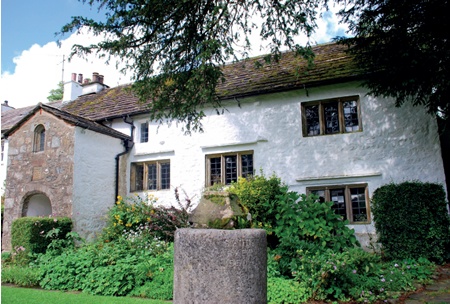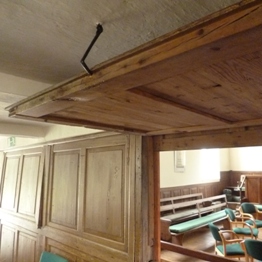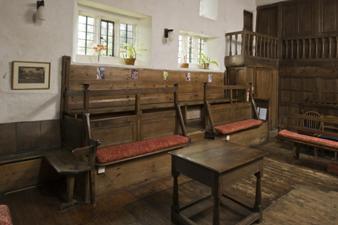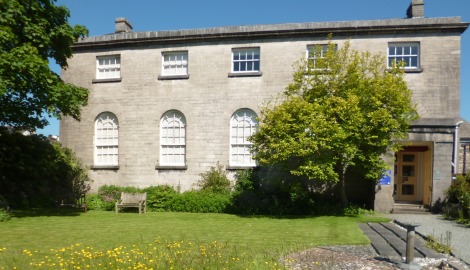Quaker Meeting Houses in Britain
Marion Barter, Ingrid Greenhow and Linda Monckton
 |
|
| Brigflatts Meeting House (1675, Grade I), on the edge of the Yorkshire Dales (Photo: Andrew Green) |
The Quaker movement had its origins in the religious and political turmoil of the mid-17th century. George Fox, from Leicestershire, became the main protagonist of the movement, turning his back and pouring scorn on the established church. Fox claimed that each person can have a direct relationship with God, so there was no need for priests or churches (or ‘steeple houses’, as Fox dismissively called them). From around 1647 he travelled on foot as an itinerant preacher and, during a journey to the North of England, he met groups of Seekers or Separatists, who were already open to new ideas. The term Quaker was first used in about 1650 and Quakers – formally, the Religious Society of Friends – are also known simply as Friends.
The movement emerged in 1652, when large gatherings heard Fox speak in the open air in Cumbria and Yorkshire, on hillsides such as Firbank Fell near Sedbergh, places which are arguably as important to Quaker heritage as the meeting houses built later in the 17th century. Fox, who recorded his journeys and beliefs in a series of journals published in the 1670s, observed that ‘the ground and the house were no holier than another place’. Early Friends met together in silent worship in barns, orchards, on hilltops and in each other’s homes. Intolerance and persecution were constant threats to the ability of Quakers to meet. Such persecution affected all those of faith who chose not to conform to the established church, but Quakers were singled out in 1662 by the passing of the Quaker Act, which led to further imprisonments simply for attending Quaker meetings. The level of persecution led some Quakers to leave England for America where, in 1681, Pennsylvania was founded by the Quaker William Penn.
Some meeting houses in England were built during this time of persecution, for example Broad Campden in the Cotswolds (1663), the earliest meeting house built in Britain, and that at Hertford (1670), which is the oldest purpose-built meeting house in continuous use. The Quaker congregation, or ‘meeting’, in Hertford had started as early as 1655 (just three years after the foundation of the movement) and met in a local butcher’s house. He purchased land to serve as their burial ground and a meeting house was later built on land belonging to another local Friend.
In some cases the burial ground was the first piece of land acquired by a Quaker meeting and many pre-date the building of the meeting house. From the mid-17th century, Quakers were either denied the right to bury their dead in the parish graveyard, or chose not to. To begin with they carried out burials in gardens and orchards, but they began to acquire their own burial grounds, following guidance from Fox, who urged Friends ‘to buy decent burying-places’ and to ‘let them be decently and well fenced’. David Butler, in his comprehensive two-volume survey, The Quaker Meeting Houses of Britain (see Further Information) notes that ‘nearly half of all burial grounds were acquired before 1700’. Most burial grounds were enclosed by high walls, with a secure gated entrance in the often higher front wall. In London’s Bunhill Fields cemetery, a small plot was acquired by the Quakers in 1661 and gradually expanded over the next two centuries until its closure in 1855. Early burial grounds were also used for open-air meetings. Near Hawkshead in Cumbria, for example, Quakers acquired a burial ground at Colthouse in 1668 and built stone benches against the boundary walls for the meetings they held there until the meeting house was built in 1688.
The Act of Toleration, passed in 1689, was one of several steps towards freedom of worship outside the established church, and thereafter meeting houses began to make their mark on the landscape.
ARCHITECTURE AND DESIGN
David Butler identified 1,300 existing and former meeting houses across Britain in 1999. Today there are 475 Quaker meetings in England, Wales and Scotland. Of these, 354 have a dedicated meeting house, while the rest meet in rented premises or private houses.
 |
|
| Blackheath Meeting House, Blackheath, London (1972, not listed): designed by the notable modernist architect Trevor Dannatt, it features a distinctive raised square lantern. (Photo: AHP) | |
 |
|
| Colthouse Meeting House, Cumbria (1688, Grade II*): timber screen with shutters, c1700 (Photo: AHP) |
The earliest purpose-built Quaker meeting houses were distinctive for their simple, functional design. Built by local craftsmen, they sit modestly in the town and landscape and have a vernacular character. In some cases, an existing building was adapted. Originally a barn and cottage, Swarthmoor meeting house in Cumbria was bought by George Fox and given to the local meeting in 1688 with instructions on how to adapt it as a meeting house. Early meeting houses have simple internal spaces, reflecting the way in which Quakers worshipped. As architect and Quaker Hubert Lidbetter observed in his 1961 survey of Quaker places of worship: ‘With no necessity to provide for music or any set form of service, a Meeting House is more a domestic than an ecclesiastical building’ (see Further Information).
The key characteristic of a late 17th-century meeting house is the two-room asymmetrical plan where the larger space is a full-height room used for worship and the smaller space is used for the women’s business meeting, often with a loft or gallery above the latter so that this end of the building has two storeys. One front entrance led to internal doorways, either directly from a porch or leading off a through-passage. With no priest or altar, there were no liturgical requirements to influence the design of the building, and decoration in the form of stained glass, coloured decoration or moulded ornament is very rare. Walls and ceilings are usually plainly plastered (originally lime-washed), floors were laid with stone or plain pine boards, and very simple fittings such as dado panelling (usually in pine) were provided.
Internally, the two meeting spaces were separated by a timber partition constructed so that part could be opened to enable men and women to meet separately for business or together for worship. A distinctive feature of Quaker meeting houses, early moveable screens were constructed of timber panelling with wrought iron hinges and hooks. The design evolved over time and by the 19th century, vertically-sliding panels were in use and innovative methods for opening large screens were included such as mechanical winches in the roof as at Kendal (1816) and Manchester (1831).
From 1896, separate meetings were discontinued and a moveable screen was no longer needed. Instead, separate rooms were used for education and other community activities. The layout of the main meeting room reflected the Quakers’ approach to worship and although there was an emphasis on simplicity and equality, a raised platform at one end of the meeting room was used to provide seating for the Elders and for recorded ministers. Elders are regularly appointed individuals responsible for the spiritual life of the meeting.
The rest of the bench seating faced this raised stand, where a front rail was provided for ministers and Elders to lean against when standing to speak. The stand was fitted with benches and wall panelling, but its use declined after 1924 when recorded ministers were no longer recognised. Thereafter, the ministry of all Quakers was equally valued and Friends sat together on one level. This change eventually led to the current pattern of seating arranged in a square or circle.
The asymmetric plan influenced distinctive elevations, with tall windows serving the main meeting room and two levels of smaller windows for the women’s business room and the loft. The exterior of early meeting houses followed traditions in local domestic architecture, whether constructed in timber-framing, brick or stone, and with roofs of thatch, tile or slate. Exteriors were influenced by trends in polite architecture from around the late 18th century and windows changed from mullioned windows to vertically sliding sashes. Architects became more involved in designing meeting houses and some meeting houses built in towns, such as that in Manchester (Richard Lane, 1831), reflected the classical revival. In the early 20th century neo-Georgian and domestic revival styles were popular, including meeting houses by Hubert Lidbetter and Fred Rowntree. Post-war meeting houses followed contemporary trends in materials and form while maintaining simplicity.
The use of words such as simplicity and plainness to describe their buildings – and sometimes their approach to worship too – somewhat masks the complexity of the relationship between Quakers and their buildings. Their origins were as a radical movement and this was to be reflected in their public witness (such as their opposition to slavery), which emerged out of their spiritual approaches. Equally their buildings are infinitely more varied and responsive than the usual characterisation suggests. Furthermore, their adaptation to new social challenges is matched by, or perhaps reflected in, their buildings’ evolution in response to contemporary challenges.
EXAMPLES
The observations made above are well illustrated by the examples of Brigflatts, Blackheath and Kingston upon Thames.
Brigflatts (1675), on the edge of the Yorkshire Dales, is associated with visits to the area by George Fox. Grade I listed, it is the earliest purpose-built meeting house in the north of England. Its construction is typical of late-17th century vernacular in the locality and it retains many historic fittings. Its setting includes the burial ground, in continuous use since 1656 and where the poet Basil Bunting is buried, a garden, paddock, warden’s house, a little-altered gig house and stable with classroom (Grade II). The interior retains a wealth of oak fittings including a minister’s stand (a raised area on one side of the meeting house where Quakers travelling in the ministry would have sat), fixed benches, a wide staircase (with dog gate), raised galleries on three sides and an Elders’ bench. A screen remains with panelling and turned hat pegs. Originally moveable, the screen is now fixed shut.
 |
|
| The interior at Brigflatts, which retains a wealth of historic oak fittings including a minister’s stand, Elders’ bench and raised galleries on three sides (Photo: © Historic England Archive) |
The Blackheath Meeting had several locations before the 1970s in Woolwich and Deptford, including its own small meeting house and various rooms in other faith buildings. In 1972 a new concrete building was designed by Trevor Dannatt, a notable figure in post-war modernist design. It was described at the time as a ‘modern building to fit in with the forward-looking community around it’ and received a Civic Trust Award in 1973 and a commendation by the Concrete Society in 1974. It is described by AHP as a ‘small, jewel-like Brutalist design (terms not usually conjoined), ingeniously planned to overcome and then exploit the level changes presented by the site. The chamfered square plan form evokes a medieval chapter house, and the raised square lantern acts as a beacon’.
The Kingston upon Thames meeting house is a multi-purpose building designed by John Langley of Tectus Architecture. It is a single-storey, flat-roofed pavilion with a colonnade of pale steels supports. It was a joint winner of the ACE/RIBA award for religious architecture in 2015 as a vital community centre with a moving and well-composed meeting room. Making extensive use of natural light and surrounded by an informal garden, the meeting house directly reflects a Quaker priority of sustainability and adaptation in response to climate change. It leads the way as Quakers also endeavour to make their own lives and their older meeting houses as environmentally friendly as possible.
Kingston’s focus on the broader community highlights another important feature of Quaker meeting houses: they are not regarded as sacred spaces because Quakers maintain that the whole of life is sacramental and that no place or date is more sacred than another. This enables meeting houses to be used for a variety of purposes, including interfaith activity because of their plainness, and the current research project discussed below is demonstrating a high level of communal value and community use.
Edinburgh Central Meeting, housed in a converted Victorian building above the Grassmarket, provides a venue for the Edinburgh Fringe Festival, while Kendal (1816), which was proving too large for the local Quaker population, has been divided to provide a home for the Quaker tapestry, a modern 77-panel collaborative work exploring Quaker history and beliefs. On a more modest scale, but important locally, yoga classes, playgroups, peace groups and fellowship groups such as Alcoholics Anonymous all benefit from using meeting houses.
 |
|
| Kendal Meeting House, Cumbria, by Francis Webster (1816, Grade II*) (Photo: AHP) |
Historic England is working on a jointly-funded project – the Quaker Meeting Houses Heritage Project – with the Religious Society of Friends to provide a survey of all Quaker meeting houses in England that are currently being used for Quaker Worship. The Architectural History Practice has been commissioned to produce the reports over the two and a half year project (2014-2016). Volunteer Friends are also involved in contributing to the project and the results are being made available online (see Further Information). The Quakers have extended the survey to cover Scotland, Wales and the Channel Islands and two buildings significant to Friends: Friends House in London and Swarthmoor Hall in Cumbria.
The current project is considering heritage values, accessibility, sustainability, management and community use to provide a base-line of vital information to support better management and appreciation of the Quaker built heritage. This largely unsung group of fascinating and surprisingly varied buildings reflects the history, attitudes and ethos of the Quaker movement.
Further Information
Architectural History Practice, Quaker Meeting Houses Heritage Project, 2014-2016
D Butler, The Quaker Meeting Houses of Britain, vols I and II, Friends Historical Society, London, 1999
Historic England, Nonconformist Heritage
Pink Dandelion, An Introduction to Quakerism, CUP, Cambridge, 2007
H Lidbetter, The Friends Meeting House: An Historical Survey of the Places of Worship of the Society of Friends, W Sessions, York, 1961
C Stell, Nonconformist Chapels and Meeting Houses in Eastern England, RCHME/HMSO, London, 1986 (see also Stell’s later works on chapels and meeting houses in other regions of England)
C Wakeling, The Chapels of England, Historic England, 2017



